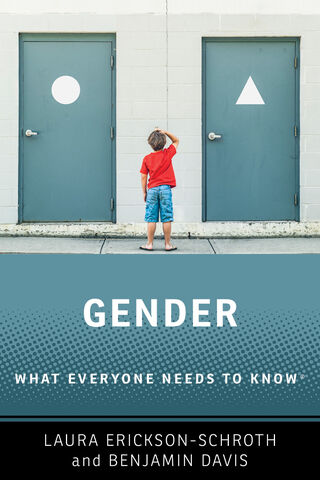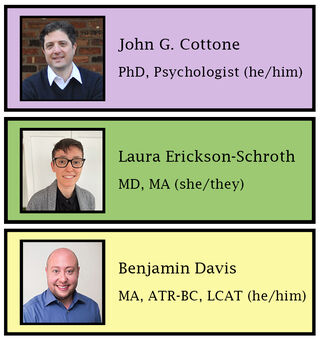Gender
Gender in the 21st Century: What You Need to Know
An interview with gender experts and authors Ben Davis & Laura Erickson-Schroth.
Posted November 15, 2021 Reviewed by Davia Sills

Whether you’re a parent, educator, or health care provider, the growing awareness of gender-diverse identities in the 21st century demands continued education to ensure that those in your care are understood and treated with respect.
Apropos of this, I was fortunate to read a new primer on the subject—Gender: What Everyone Needs to Know—that I believe should be required reading for anyone who wants a contemporary understanding.
I recently had an opportunity to interview the authors of Gender: What Everyone Needs to Know, psychiatrist Laura Erickson-Schroth, M.D., M.A., and art therapist and educator Benjamin Davis, M.A., ATR-BC, LCAT. Although their book is so easy to read that individuals across the spectrum of gender sophistication should find it accessible, I wanted to hear directly from two experts in the field about what they believe everyone should know about gender in the 21st century.

~~~~~~~~~~~~~~~~~~~~~~~~~~~~~~~~~~~~~~
JGC: John G. Cottone, Ph.D.
LES: Laura Erickson-Schroth, M.D., M.A.
BD: Benjamin Davis, M.A., ATR-BC, LCAT
~~~~~~~~~~~~~~~~~~~~~~~~~~~~~~~~~~~~~~
JGC: What was the impetus for writing this book? Were you motivated by anything in your personal lives, or was it driven by a need you observed in your academic or professional work?
LES: As clinicians working with LGBTQ people and teaching workshops about these issues, we get questions about gender every day—from family members and friends of queer and trans people, from our colleagues and students, and at social gatherings. We’ve both always wished there was a one-stop resource to point to for all the questions people have about gender.
Oxford’s What Everyone Needs to Know series provides the perfect format for this. Each chapter addresses a separate gender-related topic by asking and answering a set of questions. These range from “What does it mean to be transgender?” to “What is patriarchy?” to “What is gender-neutral parenting?” We had a lot of fun thinking about and researching these questions, and we hope this book will be both entertaining and informative for readers.
BD: When Laura approached me to collaborate on this book, I was really excited to produce something that was reader-friendly and easily digestible. As we were formulating questions, I kept thinking about the things I wished people knew about before entering specific conversations or debates about gender—the baseline history and science of it all. And as a transgender person, I felt it was important to create a gender-inclusive primer that could provide accessible, relevant, and accurate information to readers—so much of what was out there was written for and about cisgender people, leaving out the diversity of trans and nonbinary perspectives.
JGC: What are some common misconceptions about gender that you hope to address with your book?
LES: It’s interesting. Gender is something that’s all around us, and at the same time, many of us never learn anything about it in school. This can lead to a lot of confusion, even about basic concepts.
Many people don’t know that gender and sex are different. Sex refers to body parts, while gender refers to identity. A common belief is that there are only two sexes. In fact, there is significant diversity in our bodies, including many people known as intersex whose bodies don’t match traditional understandings of male or female.
People also have a wide range of gender identities that may or may not line up with our sexes assigned at birth, and a large number of people identify as nonbinary—outside of the male/female binary. It is a common misconception that transgender and nonbinary identities are new, but they have existed, in some form, in cultures all over the world and across time.
JGC: How would you hope clinicians approach gender-diverse/transgender/nonbinary clients?
BD: We would encourage clinicians to approach all their clients with respect, curiosity, and compassion while staying particularly aware that many transgender, nonbinary, and gender-diverse individuals have had discouraging or even traumatic relationships with previous mental health providers. With regard to access to medical transition, we are still in a system of gatekeeping, where mental health clinicians must provide letters of support for a client seeking gender-affirming care. A clinician should be aware of these power dynamics and may want to bring them up in treatment early on, depending on the case.
JGC: Might cisgender clients also benefit from exploring gender in psychotherapy?
BD: Absolutely. In fact, in your article, “The Unwritten Rules of Boyhood and Girlhood,” I think you made insightful points about the ways gender norms, social expectations, and internalized assumptions about one’s own thoughts and behavior can have a profound effect on the development of identity and psychological well-being, even among cisgender individuals. Laura and I believe that unpacking all of this can add shades of nuance to an individual’s identity—cisgender or otherwise—within the context of one’s family upbringing and sociocultural experience.
JGC: Do you have any recommendations for individuals—especially children—who are questioning their gender identity, sexual identity, or sexual orientation?
BD: Find a community of peers—other people (other young people or parents of young people) who are relatable and experiencing something similar at the same time. Not only does this help reduce feelings of isolation, but it also allows for someone to see and internalize new models for themselves and their future, whether that means having more examples to draw on about coming out, more experiences to think about when imagining oneself getting older or joining the workforce, entering or ending relationships. Since most of our models are cisnormative and heteronormative, sometimes seeing a fellow LGBTQIA person just live their life can allow our brains to think differently, and more hopefully, about our own lives and futures.
JGC: Do you have any recommendations for parents and friends to best support their loved ones without invalidating them?
BD: Similarly, find community! Most parents assume a child to be cisgender (and often heterosexual) and have written a mental script for their future based on these assumptions. Even a fully accepting parent or family member might need support in adjusting their narrative.
For someone who doesn’t have much contact with LGBTQIA communities, coming up with new mental models can be really difficult, particularly if the few stories one does have access to depict suffering or tragedy. Seeing and experiencing LGBTQIA individuals as joyful, successful, connected, loved, and aging can serve as a powerful tool for parents, friends, and family members in better understanding their LGBTQIA loved ones and supporting them into the future.
JGC: Do you have any favorite gender-related books other than this one?
LES: Yes! There are so many fantastic books about gender that we almost don’t know where to start. If you’re looking for nonfiction, Thick (Tressie McMillan Cottom) and Just Us (Claudia Rankine) are two great explorations of race and gender in America. Heavy (Kiese Laymon) explores the author’s deeply personal journey, touching on issues of race, body image, and masculine identity. On Earth, We’re Briefly Gorgeous (Ocean Vuong) similarly goes to a vulnerable and beautiful place. Everything by Roxane Gay (Hunger, Bad Feminist) is accessible and thought-provoking.
In the realm of fiction, some great sci-fi/fantasy books include Paul Takes the Form of a Mortal Girl (Andrew Lawlor), The City We Became (N.K. Jemison), Freshwater (Akwaeke Emezi), and The Power (Naomi Alderman). Octavia Butler (Kindred, Parable of the Sower) had an incredible talent for exploring gender in interesting ways. On trans topics, Trans Bodies, Trans Selves (edited by Laura) is a great introduction to trans lives for both trans people and allies. A new edition is due out in a few months. For the academically inclined, Transgender History (Susan Stryker) is a detailed look back on how we got where we are. There are also a number of great memoirs by trans authors, including Janet Mock’s Redefining Realness and Kai Cheng Thom’s I Hope We Choose Love.
JGC: Are there any questions about gender that you still have, which you hope future research might help us better understand?
BD: I want to know more about the gender development trajectories of kids who are not raised with binary, cisnormative gender roles and models. When “boy” and “girl” are less polarized, hierarchical, and not based entirely on one’s genitals, how do kids make sense of their own gender identity and those of others? I think we will learn a lot from this generation of young people and those to come.
LES: I’d love to see what our world could look like if we raised children the way Ben is describing. What would the effects be on the ways we socialize, work, play, form relationships, and care for our planet? We’ve seen this in science fiction, but what about in the world where we actually live? How would it play out?
---------------------------------------------------------------
Benjamin Davis, M.A., ATR-BC, LCAT (he/him) is an art therapist, educator, and the founder and clinical director of Full Spectrum Creative Arts Therapy, a group psychotherapy practice focused on providing affirming care for queer and transgender young people and adults. Since 2005, Benjamin has worked to address the mental health concerns of LGBTQIA individuals, formerly serving as the Deputy Director of the Ackerman Institute’s Gender & Family Project and faculty member at New York University’s Steinhardt School of Education, Culture, and Human Development. Benjamin has co-authored two books: Oxford University Press’ Gender: What Everyone Needs to Know (2020) and Art Therapy Practices for Resilient Youth: A Strengths-Based Approach to At-Promise Children and Adolescents (Routledge, 2019).
Laura Erickson-Schroth, M.D., M.A. (she/they) is a psychiatrist at Columbia University Medical Center and Hetrick-Martin Institute for LGBTQ+ Youth. She is the co-author of Gender: What Everyone Needs to Know (Oxford, 2021), as well as editor/author of two other books, Trans Bodies, Trans Selves (Oxford, 2014), an award-winning resource compendium written by and for transgender people, and “You’re in the Wrong Bathroom,” and 20 Other Myths and Misconceptions about Transgender and Gender Nonconforming People (Beacon Press, 2017). Laura has appeared on NPR’s Fresh Air and On Point and is a former board member of the Association of LGBTQ+ Psychiatrists and GLMA: Health Professionals Advancing LGBTQ Equality.
References
Gender fluidity: What it means and why support matters - Harvard Health
https://www.health.harvard.edu/blog/gender-fluidity-what-it-means-and-w…




